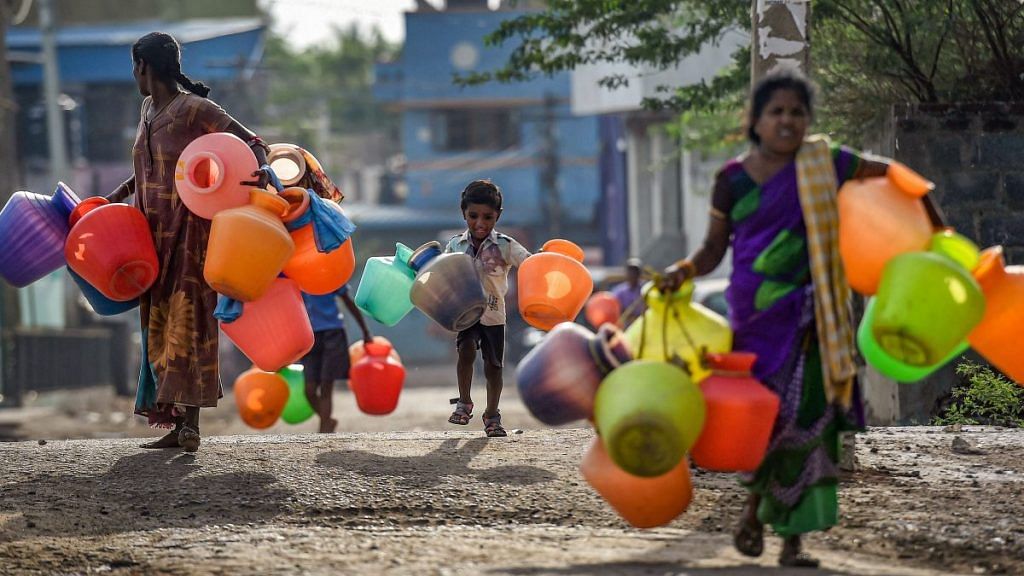Blessed with hundreds of lakes and water bodies, both big and small, and above average rainfall, about 1,200 to 1,300 mm per annum – Chennai’s crisis is not caused by water. Tamil Nadu’s capital city is in a mess today because of its governance.
The Second Master Plan, which was notified in 2008 had the following as its ‘vision’ for 2026: “To make Chennai a prime metropolis which will become more livable, economically vibrant, environmentally sustainable and with better assets for the future generations.”
Unfortunately for the city’s residents, Chennai’s urbanisation is not being guided by this Master Plan, and the development agenda is now largely driven by real estate. In the process, Chennai has lost several water bodies and more than one-fifth of its greenery in 20 years. By 2026, it may be down to one-third.
The biggest casualty of this predatory ‘development’ has been water management, something that the city previously experienced in December 2015. Floodwaters from annual monsoon rainfall rose and turned into a deluge, causing unprecedented death and destruction.
Also read: Chennai water crisis is a man-made disaster. Other Indian metros may suffer the same fate
Chennai’s civil society mobilised itself to form a ‘Citizens Platform’ and held several sessions. Participants, numbering over 1,000, were either the victims of the floods or had plunged in to rescue others and provide relief work at a time when the state apparatus stood still. The group represented diverse sections of society from various parts of Chennai, and neighbouring Kanchipuram and Thiruvallur districts. I was part of this exercise.
Out of the several intense interactions, a consensus evolved that the Chennai floods were the result of a combination of factors, the most important being the large-scale destruction of nature’s right of way and storage by heavily encroaching on waterways, water bodies, marshes and mudflats.
Based on people’s inputs, Citizens Platform placed its demands before the state government in April 2016. Prominent among these were:
- Frame a visionary, regenerative water governance and security policy, and implement it by prioritising the retrieval, rehabilitation, protection and maintenance of all water resources, associated common lands, and water management structures.
- Identify the large-scale encroachments by permanent structures constructed in marshes, mudflats, waterbodies, watercourses, their catchments, floodplains or associated common lands and other prohibited areas, and have them removed.
- Clear all obstructions such as accumulated construction debris or garbage and weeds from all waterbodies, waterways, stormwater drains and de-silt them.
- Undertake a review of large-scale projects that are under construction or proposed in sites of inter-tidal zones, sand dunes, mudflats or other coastal common lands in order to prevent adverse environmental impacts, including the threat to water security.
Also read: Chennai’s water crisis is only getting worse, and there’s no relief in sight
None of these seems to have been implemented and a metropolis that virtually floated on water five years ago is now starved of it. This is clearly a governance failure. Chennai’s present population of about 10 million is estimated to reach 12.5 million by 2026.
With the city experiencing a strange phenomenon of deluge as well as severe water scarcity, it is better to light a candle –in Chennai’s case, water management — than to curse the darkness. Water management has two dimensions. One, to prevent and abate floods; and two, to assure year-round access to good quality of water for drinking, industrial and other purposes.
To achieve the former, Chennai and its citizens need comprehensive vulnerability analysis, risk mitigation policy, and resilience capacities. This requires severe curtailment of urban sprawl and chalking out a flood control/water security plan as well as an implementation mechanism that is visionary, regenerative and adaptive to climate change. The latter would involve the creation of innovative and sustainable water harnessing, harvesting, conservation, distribution and delivery system methods, with a plan that effectively implements these methods.
It is, therefore, imperative to design an Integrated Water Resource Management (IWRM) blueprint for Chennai and make it part of urban planning, development and governance. Such a blueprint, inter alia, should include rain-audit, accounting of complete entities and population-industries, commercial establishments, institutions, apartments and households among others in the city. It should also contain a complete water ‘mass-balance’ and mapping of the available water resources to help fill the supply-demand gap.
Also read: As Chennai water woes mount, here’s the audit report Tamil Nadu govt wanted buried
This blueprint should cover sustainable ground and surface water abstraction; wastewater discharge, treatment and reuse; water conveyance and distribution efficiency; sanitation services; public toilets and baths; stormwater collection and draining system; rainwater harvesting; flood control measures; groundwater and aquifer conservation and recharging; reservoir optimisation and storage efficiency; cleaning and desilting of rivers and waterways; waterbodies linkage and networking; demand-side management; community-based decentralised initiatives; and technology-driven smart solutions.
Chennai metropolis is being projected as a global business destination while its natural environmental infrastructure and resources like land, air, water, and coastal ecosystem are shrinking, deteriorating and degenerating fast. Water being the most critical among these, it is essential that an IWRM system is put together and made operational without any delay. Sadly, though, the AIADMK government of E. Palaniswami and the system of governance currently in place do not seem to be attuned to this.
The author is a former Army and IAS officer. Views are personal.
